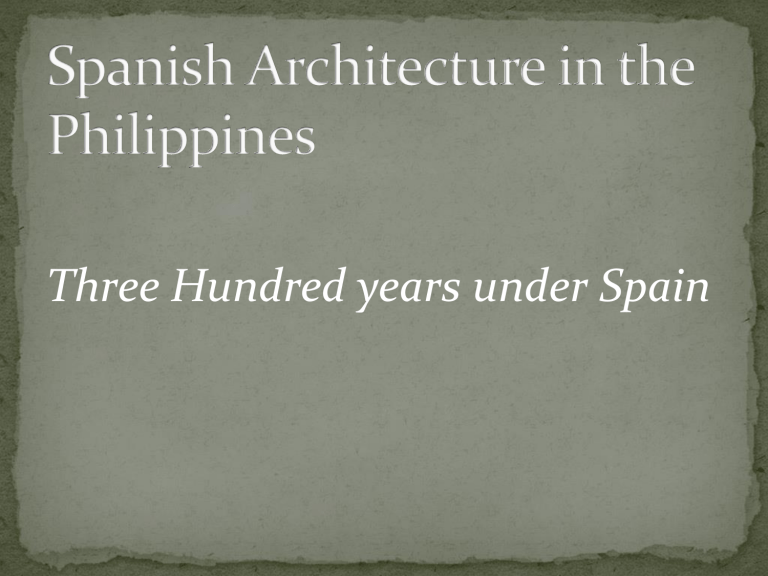
Three Hundred years under Spain Stone tools in Cagayan Valley- 150,00030,000 BC Burial Sites in Tabon Caves, Palawan200 BC Malay Immigrants - Barangay System - Words and modes of writing - Legends and Epic (related to Hindu) China – started before 10th century -use of pocelain through trade (wiped out local pottery industry) - Art of metallurgy (gun powder) - Loose fitting dress and slippers - Arranged marriages Japan- 17th century AD -Agricultural tools -Fish breeding method - Breeding of Ducks - Tanning of deer skins Hindu-Malay – 14th Century -Sultanate form of Government - Arabic Script - Muslim Art and Science - Use of Firearms - Mohammedan Calendar, laws and literature - Ferdinand Magellan - Island of Samar on - - - March 17, 1521 Cebu -April 1, 1521 First baptism which includes Queen Juana (wife of chieftain Humabon) Magellan got involved in rivalries between LapuLapu and Humabon Named Samar-Leyte “Felipinas” in honor of Prince Felipe (Successor of King Charles I) -there was no real opposition to the name Philippines after it was granted its independence. Exonym – name given by an outsider to a group Autonym – accepted and taken as their own - King Philip (1556) - “He was the first Spaniard fully to embody the new professional condition of the Renaissance architect” - His lifestyle, his values and aspiration - Ex. Escorial (Toledo, Herrera, with influence of Vignola and Serlio) San Lorenzo de El Escorial - Miguel Lopez de Legazpi (member of Confraternity of the Name of Jesus of the Friary of San Agustin) - Christianize the island - Established a permanent settlement to be used in the spice trade. - April 27, 1565 (44 years after Magellan) - Plenary pardon for the massacre of Magellan’s men. - Rajah Tupas shows hostile action. Open fire the native settlement from ship. - Saw in one of the burning hut the statue of Child Jesus given to Queen Juana. Push the determination of the expedition start the Christianization and colonization of the island. -a temporary chapel or church (Hut) where the statue of Child Jesus was found. - 2nd building –Friary - 3rd building – laying out the settlement (Fort) triangular in form one side face the land, 2 sides face the sea -Manila and Cebu ”Supra-barangay” - Largest PreHispanic Settlement in the Philippines Pre-historic time- areas for graves and sacred places are given more importance than selecting sites for new settlements in consideration of: Material consideration Availability of food Development of trade Climatic condition defensibility 2 Muslim Kingdoms: - Rajah Sulaiman- south bank of Pasig River - Rajah Lakandula – across the river to the north May 24, 1570 – Muslims were defeated -Luzon is rich agricultural region. - Manila was taken easily with the absence of Sulaiman who fleed, and Lakadula accepting the Spanish - Sulaiman’s settlement was donated by Lakandula to Spaniards in condition to retain Maynila’s name. - Manila – Maynilad , the place where “Nilad”, a local tree which grew on the banks of the Pasig River” Hierarchy of Settlement Patterns Ciudad (City) Ciudades (Cities) Villas (Town) Poblaciones (Villages) - Church & Covento (priests residences) focal points *Law of the Indies 3 Basic Urban Configuration Geomorphic- takes its major shape from the configuration of the ground. Concentric – one major center as focal point of arrangement Orthogonal- lines intersecting at right angles as principle of organization. the Spaniards generate money mainly through Galleon Trading (existing trade between Philippines and China) - Colonial Carving in Ivory - ivory came from Cambodia and Ceylon - Chinese trained mestizos and Filipinos - -transition from wooden building to Architecture in stone due to constant fire. Fr. Antonio Sedaño - Spaniard - Governador-General Santiago de Vera – stated to King Philip II many quarries of limestone which can be used in constructing permanent buildings. Also ordered roof tiles and bricks. - Taught Filipino and Chinese workmen his skills. Fr. Antonia de Morga Holds files contains valuable and reliable information about the architecture and urban planning of Manila around 1600. Fair judgment on prehispanic culture of the Philippines and the negative influence of the Spanish. The Manila Plan 1671- Currently located at General Archives of the Indies at Sevilla Spain If based by Kevin Lynch elements of the image of the City Paths – Streets Edges- surrounding walls Districts- areas around the plazas Nodes- Plaza Landmarks- churches Established a policy to segregate Chinese community on the Northeast corner of the walls. The first parian always caught fire. Second settlment of Parian was relocated further to south of Pasig River. Parian became a commercial nucleus of colonial Manila. Spaniards felt responsible for Christian Chinese with Filipina wives. Therefore allowed another settlement which is now Binondo “ Isla de Binondoc” Hochbau- Vertical development Cathedral or Churches Schools Hospitals Residentials 1st -made of wood, bamboo, nipa (burnt down) 2nd- made of stone but destroyed by an earthquake 1600 3rd- has 3 naves, seven chapels, 10 altars 4th- constructed on arrival of Archbishop Miguel de Poblete. Manila Cathedral de Poblete is Romanesque in style. S. Vicente de Castillo Interior towards the apse shows piers with set-back corners similar to Manila Cathedral de Poblete Remodeled by Fr. Juan de Aguccioni Demolished the last two piers of the main nave, last two side chapels on either side, rooms behind the altar to gain sifficient space for the transept and a semi circular apse for the altar. 2 piers on the transept to carry stone arches. Construct a dome with to admit more natural light and add clerestory. Attach Ionic capitals to add proportion to the structure and represent gentle feminine expression. The general plan of the building was Byzantine Details are Byzantine, Romanesque, Gothic, Baroque. First built with bamboo and Nipa but later burnt Reconstructed with bamboo, Nipa and wood but burnt again Decide to built with stones in 1587 by allegedly nephew of Juan Antonia de Hererra. Major features of later western medieval monastery Two tower entrance façade First earthquake proof building in stone in Philippine soil Romanesque style Miagao “Fortress” church Miagao was constantly invaded by the “Moros” for almost a decade in the mid-18th century moved to a more secure place, so a new fortified church was then built at the highest point of the town Filipino-Hispanic Rococo -combine fanciful and elegant designs of shellwork and foliage of Rococo Architecture with scrolls, rocailles, and Philippine Flora and fauna as ornamental motifs. San Joaquin Campo Santo Baroque Style Features a hexagonal floor layout, a dome made from galvanized roofing, and walls consisting of a mixture of corals and fossils collected from the coast and red clay bricks. La Loma Funeral Chapel, La Loma, Manila Built to house a miraculous image with passages way behind the altar for veneration to the image of the devotees. Minor Basilica of the Black Nazarene/ Parish of Saint John the Baptist (Quiapo, Manila) style defined by lower and wider bases, thick sidewalls, upper structures made with light materials, and low bell towers, with the bells often detached to avoid its inevitable fall in the event of an earthquake. Church of San Agustin in Ilocos Norte - Churches reviving the spirit of Gothic architecture in late 12th to mid 16th century, characterized by pointed arch, ribbed vault, flying buttresses, tracery windows, slender pier and column. Basilica Minore de San Sebastian The hybrid type of house first built in Intramuros, Manila in the 17th century before spreading throughout the century combining European classical elements, architectural elements of the Chinese houses, and architecture and climate-responsive elements of the traditional lowland houses or bahay kubo . Unique with the house is the use of bintanang capis and extensive use of sustainable elements such as double facede, wide eaves and awnings, louvers, floor-to-ceiling operable walls and partitions to maximize natural daylight and ventilation, cross and stack ventilation systems, and open courtyard as sun and wind catchers.



